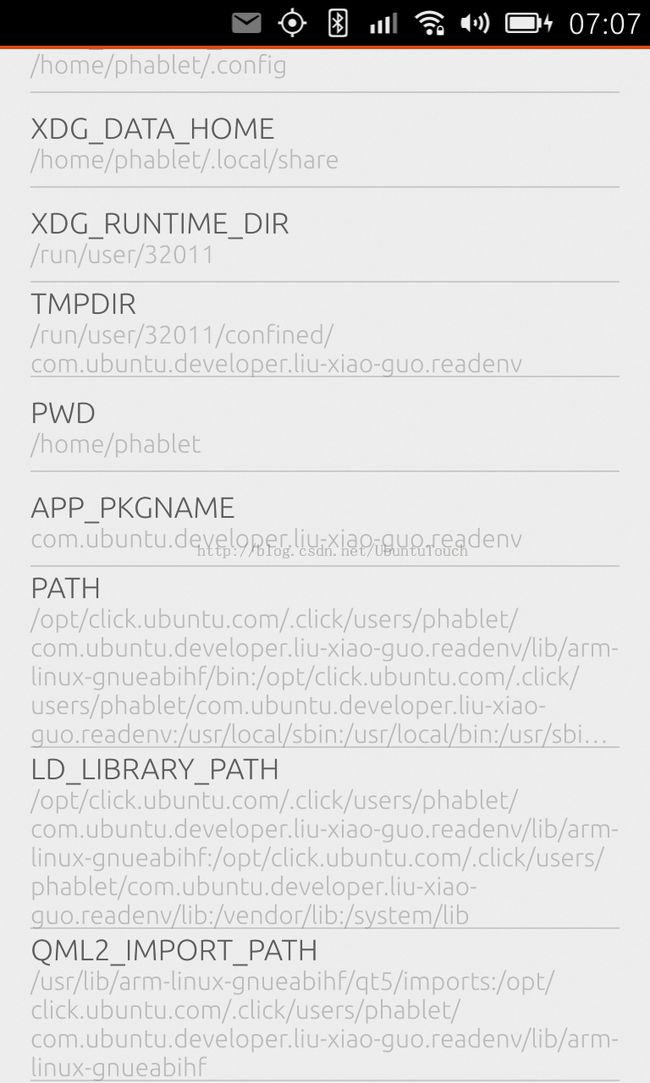Ubuntu OS应用Runtime Enviroment
在这篇文章中,我们将介绍Ubuntu OS的Runtime Environment。在文章“App confinement: Security policy for click packages”中,我们看见它里面有介绍一个应用的runtime环境。这里,我们通过一个例子来显示一个应用的runtime环境到底是怎样的。
在这里我们可以参阅我以前的文章“在Ubuntu上的C++及QML混合编程”,我们下载文章中的例程:
bzr branch lp:~liu-xiao-guo/debiantrial/readenv
在一个Terminal中打入上述的句子,就可以下载例程中的软件。同时,我们对我们的主程序文件“ReadEnv.qml”做如下的修改:
import QtQuick 2.0
import Ubuntu.Components 0.1
import Ubuntu.Components.ListItems 0.1 as ListItem
import ReadEnv 1.0
import "ui"
/*!
\brief MainView with Tabs element.
First Tab has a single Label and
second Tab has a single ToolbarAction.
*/
MainView {
id: root
// objectName for functional testing purposes (autopilot-qt5)
objectName: "mainView"
// Note! applicationName needs to match the "name" field of the click manifest
applicationName: "com.ubuntu.developer.liu-xiao-guo.ReadEnv"
anchorToKeyboard: true
/*
This property enables the application to change orientation
when the device is rotated. The default is false.
*/
//automaticOrientation: true
width: units.gu(50)
height: units.gu(75)
property string app_pkgname
ReadEnv {
id: readEnv
}
Flickable {
id: scrollWidget
anchors.fill: parent
contentHeight: contentItem.childrenRect.height
boundsBehavior: (contentHeight > root.height) ? Flickable.DragAndOvershootBounds : Flickable.StopAtBounds
/* Set the direction to workaround https://bugreports.qt-project.org/browse/QTBUG-31905
otherwise the UI might end up in a situation where scrolling doesn't work */
flickableDirection: Flickable.VerticalFlick
Column {
anchors.left: parent.left
anchors.right: parent.right
ListItem.Base {
height: ubuntuLabel.height + runtime.height + units.gu(6)
Column {
anchors.left: parent.left
anchors.right: parent.right
anchors.centerIn: parent
spacing: units.gu(2)
Label {
id: ubuntuLabel
anchors.horizontalCenter: parent.horizontalCenter
text: ""
fontSize: "x-large"
}
Label {
id: runtime
anchors.horizontalCenter: parent.horizontalCenter
text: "Runtime Environment"
}
}
}
ListItem.Subtitled {
text: i18n.tr("UBUNTU_APPLICATION_ISOLATION")
subText: readEnv.getenv("UBUNTU_APPLICATION_ISOLATION")
}
ListItem.Subtitled {
text: i18n.tr("APP_ID")
subText: readEnv.getenv("APP_ID")
}
ListItem.Subtitled {
text: i18n.tr("XDG_CACHE_HOME")
subText: readEnv.getenv("XDG_CACHE_HOME")
}
ListItem.Subtitled {
text: i18n.tr("XDG_CONFIG_HOME")
subText: readEnv.getenv("XDG_CONFIG_HOME")
}
ListItem.Subtitled {
text: i18n.tr("XDG_DATA_HOME")
subText: readEnv.getenv("XDG_DATA_HOME")
}
ListItem.Subtitled {
text: i18n.tr("XDG_RUNTIME_DIR")
subText: readEnv.getenv("XDG_RUNTIME_DIR")
}
ListItem.Subtitled {
text: i18n.tr("TMPDIR")
subText: readEnv.getenv("TMPDIR")
}
ListItem.Subtitled {
text: i18n.tr("PWD")
subText: readEnv.getenv("PWD")
}
ListItem.Subtitled {
text: i18n.tr("APP_PKGNAME")
subText: app_pkgname
}
ListItem.Subtitled {
text: i18n.tr("PATH")
subText: readEnv.getenv("PATH")
}
ListItem.Subtitled {
text: i18n.tr("LD_LIBRARY_PATH")
subText: readEnv.getenv("LD_LIBRARY_PATH")
}
ListItem.Subtitled {
text: i18n.tr("QML2_IMPORT_PATH")
subText: readEnv.getenv("QML2_IMPORT_PATH")
}
}
}
Component.onCompleted: {
var APP_ID = readEnv.getenv("APP_ID");
console.log("APP_ID: " + APP_ID );
app_pkgname = APP_ID.split('_')[0]
console.log("APP_PKGNAME: " + app_pkgname);
}
}
我们可以通过我们设计的ReadEnv库来读取该应用的环境变量。运行我们的程序,显示如下:
在文章中,它提到如下的目录,该应具有读和写的权限:
- XDG_CACHE_HOME/<APP_PKGNAME>
- XDG_CONFIG_HOME/<APP_PKGNAME>
- XDG_DATA_HOME/<APP_PKGNAME>
- XDG_RUNTIME_DIR/<APP_PKGNAME>
- XDG_RUNTIME_DIR/confined/<APP_PKGNAME> (for TMPDIR)
- /home/phablet/.cache/com.ubuntu.developer.liu-xiao-guo.readenv
- /home/phablet/.config/com.ubuntu.developer.liu-xiao-guo.readenv
- /home/phablet/.local/share/com.ubuntu.developer.liu-xiao-guo.readenv
- /run/user/32011/confined/com.ubuntu.developer.liu-xiao-guo.readenv
整个程序的源码在如下的地址可以找到:
bzr branch
lp:~liu-xiao-guo/debiantrial/runtimeevn
一个更加完整的例程在:git clone https://gitcafe.com/ubuntu/runtimeenv.git
请注意,在新的例程中,我们可以同时使用 readEnv.getenv 或 readEnv.getenv1两种方法来得到环境变量的值。
